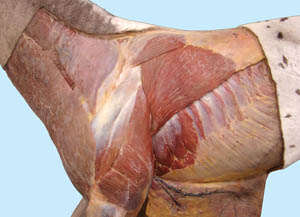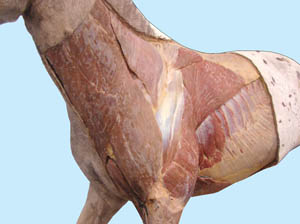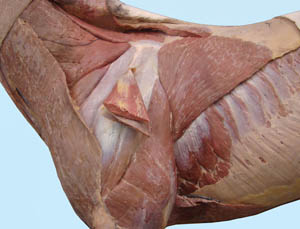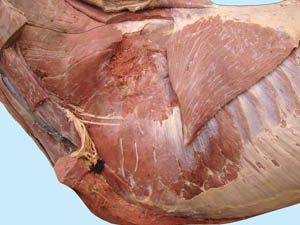LAB 1 Thoracic Limb
Forelimb Osteology,
Extrinsic Forelimb Muscles, Left Forelimb Removal
Lab Objectives:
• To study the osteology of the proximal forelimb.
• To expose the extrinsic forelimb muscles.
• To remove the left forelimb by transection of the extrinsic muscles.
Anatomical Terms:
Osteology
scapula
tuber spinae (eq, por)
supraglenoid tubercle
humerus
intertubercular (bicipital) groove
intermediate ridge
greater tubercle
lesser tubercle
deltoid tuberosity
brachialis groove
radius & ulna
interosseous space
lateral styloid process
carpal bones
radial carpal bone
intermediate carpal bone
ulnar carpal bone
accessory carpal bone
(first), second, third & fourth carpal bones
Superficial Structures of the Forelimb
chestnut
ergot
feather
coronet
Extrinsic Forelimb Muscles and Associated Structures
nuchal fatty crest
cutaneus trunci muscle
omobrachialis m.
superficial thoracic vein (spur vein)
brachiocephalicus m.
cutaneous colli m.
serratus ventralis m.
superficial pectoral mm.
descending & transverse parts
superficial cervical lymph nodules
deep pectoral mm.
ascending deep pectoral m. (caudal deep pectoral)
subclavius m. (cranial deep pectoral)
trapezius m.
cervical & thoracic parts
rhomboideus m.
cervical & thoracic parts
latissimus dorsi m.
dorsoscapular ligament
omohyoideus m.
Instructor Commentary:
The forelimb lacks a boney attachment to the trunk which is in sharp contrast with the hind limb. The entire attachment of the forelimb is by way of extrinsic muscles. The main weight bearing muscle is the serratus ventralis. If the forelimbs are thought of as posts, then the serratus ventralis is a sling that suspends the trunk by attachment to the tops of the forelimb "posts". The pectoral muscles prevent abduction of the forelimbs. Additionally, the deep pectoral muscles pull the shoulder caudally causing the forelimb "power stroke". The antagonist of the pectoral muscles is the brachiocephalicus muscle which pulls the forelimb cranially. Since the equine scapula lacks an acromion on the spine, there is no place for attachment of the omotransversarius muscle. Therefore, the omotranversarius m. forms the dorsal edge of the brachiocepalicus muscle.
Lack of boney attachment to the trunk makes the shoulder mobile and therefore increases the stride length which in turn increases running speed. Extrinsic forelimb muscles act as shock absorbers when the forelimbs make contact with the ground surface
Dissection Images:
Note: Click an image to see it enlarged, view its caption, and toggle its labels.
| 1 |  |
 |
2 |
| 3 |  |
 |
4 |
| 5 |  |
 |
6 |
| 7 |  |
 |
8 |
| 9 |  |
 |
10 |
| 11 |  |
 |
12 |
| 13 |  |
 |
14 |
| 15 |  |
 |
16 |
| 17 |  |
 |
18 |
| Previous Lab | Next Lab |
